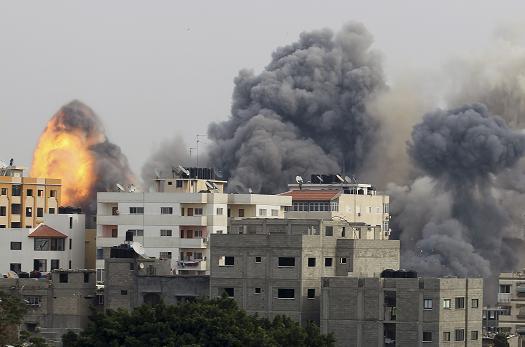The phone rang at 3:00 am: “You have five minutes to evacuate the house,” an Israeli officer said in flawless Arabic. Within minutes, an Israeli drone fired a warning shot.
The Israeli military employed a range of warnings to civilians during its November 14-21 bombardment to halt rocket fire into Israel by Gaza militants, but nevertheless civilian deaths were high.
During the offensive, 174 Palestinians were killed — including more than 100 civilians, among them at least 37 children and 14 women — and six Israelis, two soldiers and four civilians including a woman, according to both sides.
“The Israeli army called on the cell phone and gave us five minutes to get out,” said Ayman al-Ahmad Khouli, who was living with his brothers and their families, 45 people in all, in a three-storey house in Zeitun, a neighborhood of Gaza City near the border with Israel.
“In five minutes we got together and we went out into the street,” he continued, “then a drone fired a missile at one of the apartments as a warning, to show they were serious and that it was not a joke.
“Five minutes later, two missiles were fired by an F-16 aircraft; we saw the building collapse,” he recalled.
Behind the ruins of the razed house, the strike, which caused no casualties, took away the facade of the adjoining building, revealing a painting of the Dome of the Rock, in Jerusalem’s Al-Aqsa mosque compound, on the wall of a room.
“We returned to the building the same day with five youngsters,” Khouli said. “Again they fired a warning drone, then there was a new F16 raid.”
A few days before a truce between the sides went into effect the Israeli air force dropped leaflets across several districts of Gaza City near the border, urging people to evacuate their homes “immediately”.
— ‘Media objective’ —
On its website and in its press statements, the Israeli military detailed the “methods of avoiding civilian casualties,” it used, even though “these warnings ruin the element of surprise and can help the enemy to escape or call for his neighbors to serve as human shields”.
In addition to the phone calls and leaflets, it cited “diverting missiles in mid-flight”, “pinpoint targeting” and a technique called “knocking on the roof,” in which the air force targets a building with “a loud but non-lethal bomb which warns civilians… to leave the area” before the actual hit.
Despite these precautions, more than 1,000 Palestinian civilians were hurt.
The day before the raid on the Khouli home, a strike against another building in the vicinity killed four people, including two women and a child, and wounded dozens.
“This is not a warning, this is a demolition,” resident Khalil Mohammed says bitterly, sitting in front of the rubble with his eight-month-old son on his knees.
Ayman al-Khouli says the warnings served a public relations objective for the Israelis.
“They phoned us with a media objective, in order to tell the world they give warnings. If there was someone there of an armed group, Fatah, Hamas or another, they bomb without advance notice.”
According to witnesses, there was no warning shot before a strike that killed 12 people on November 18, among them 10 members of the Dallu family — mostly women and children but including Mohammed Jamal al-Dallu described by the military as “a known terrorist, belonging to the military wing of Hamas”.
“I am 100 percent sure that there was no warning, by telephone or in any way whatsoever,” says Abdelkarim Dallu, a relative. “If someone tells you he will kill you, should you stay there or flee?”











